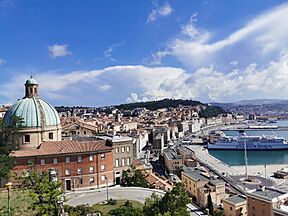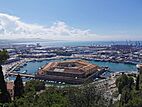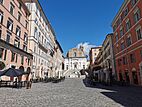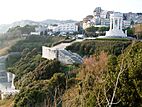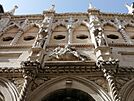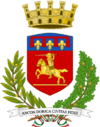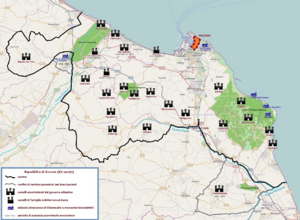Ancona facts for kids
Quick facts for kids
Ancona
|
|||
|---|---|---|---|
| Città di Ancona | |||
|
Clockwise from top: view of the city, Mole Vanvitelliana, Scalinata del Passetto and Piazza IV Novembre with the Monument to the Fallen, Loggia dei Mercanti, San Ciriaco Cathedral, Piazza del Plebiscito (Piazza del Papa), the Arch of Trajan and Arch of Clementino
|
|||
|
|||
| Country | Italy | ||
| Region | Marche | ||
| Province | Ancona (AN) | ||
| Frazioni | Aspio, Gallignano, Montacuto, Massignano, Montesicuro, Candia, Ghettarello, Paterno, Casine di Paterno, Poggio di Ancona, Sappanico, Varano | ||
| Area | |||
| • Total | 123.71 km2 (47.76 sq mi) | ||
| Elevation | 16 m (52 ft) | ||
| Time zone | UTC+1 (CET) | ||
| • Summer (DST) | UTC+2 (CEST) | ||
| Postal code |
60100, 60121–60129, 60131
|
||
| Dialing code | 071 | ||
| Patron saint | Judas Cyriacus | ||
| Saint day | 4 May | ||
Ancona is a vibrant city and important seaport in the Marche region of Central Italy. About 102,000 people live here. Ancona is the capital of its province and the Marche region. It's located about 280 kilometers (174 miles) northeast of Rome.
The city sits on the Adriatic Sea, nestled between two hills, Monte Astagno and Monte Guasco. This makes Ancona's coastline quite hilly, unlike flatter areas further north. Ancona is a major port for passenger ships and a key economic center for the region.
Contents
Ancona's Rich History
Ancient Beginnings: Greek and Roman Times
Before the Greeks arrived, the area was home to the Picentes tribes. Ancona got its start as a Greek colony around 387 BC. Settlers from Syracuse named it Ancona, which means "elbow" in Greek. This name came from the shape of the promontory that protected the harbor.
Greek traders even set up a special dye factory here. Later, when it became a Roman town, Ancona kept its own coins and continued to use the Greek language. The city's harbor was very important to the Romans. Emperor Trajan made it even bigger around 115 AD. He built a large quay (a landing place for ships) and a famous Arch of Trajan in his honor.
Medieval Ancona: Byzantine and Maritime Republic Eras
Ancona faced attacks from groups like the Goths and Lombards between the 3rd and 5th centuries. But it always bounced back! In the 7th and 8th centuries, it was part of the Exarchate of Ravenna, a territory of the Byzantine Empire. In 840, the city was attacked and burned by Saracen raiders. After Charlemagne conquered northern Italy, Ancona became the capital of the Marca di Ancona. This is where the modern region of Marche gets its name.
After the year 1000, Ancona became more and more independent. It grew into an important maritime republic, like Venice. Ancona was run by six Elders chosen from different parts of the city. It even had its own money, called the agontano. Ancona often teamed up with the Republic of Ragusa and the Byzantine Empire.
The city was strong enough to fight off attacks from the Holy Roman Empire in 1137, 1167, and 1174. Anconitan ships also took part in the Crusades. Famous explorers like Cyriac of Ancona sailed from here.
Unlike many other cities in northern Italy, Ancona usually stayed free. There was a brief period when the House of Malatesta took control in 1348. This happened after a terrible plague and a fire. But the Malatesta rulers were kicked out in 1383. In 1532, Ancona officially became part of the Papal States, ruled by the Pope. A large fortress, the Citadel, was built to show this new authority.
Ancona in Modern Times
In 1733, Pope Clement XII expanded the quay again. He also built a Lazaretto (a quarantine station) at the harbor's south end. This was designed by the architect Luigi Vanvitelli to protect the city from diseases brought by ships. Later, it was used as a military hospital. Today, it hosts cultural events.
Ancona became part of the Kingdom of Italy in 1860. This happened after a short siege where French forces surrendered.
Ancona in the World Wars
During World War I, Italy joined the Allies in 1915. The Austro-Hungarian Navy heavily bombed Ancona, causing much damage. Ancona was a vital Italian port on the Adriatic Sea during this war.
In World War II, the city was captured by the Polish 2nd Corps in July 1944. This was part of an Allied plan to get a seaport closer to the Gothic Line. This helped shorten their supply routes for the advance into northern Italy.
Jewish Community in Ancona
Jewish people have lived in Ancona for a very long time, possibly since before 967 AD. The Jewish community grew steadily from the 1300s onwards. This was because Ancona was an important trading center with the Levant (the eastern Mediterranean). Jews from Germany, Spain, and Portugal moved to Ancona to escape persecution in their homelands. They were welcomed because they played a big role in trade and banking.
In 1555, a Pope ordered the Jewish community to convert to Christianity. Some did, but others refused and faced severe consequences. In response, Jewish merchants organized a boycott of Ancona for a short time.
Later, in 1843, some old rules were brought back, forcing Jews to live in a specific area and wear special signs. However, these rules were soon canceled due to public disapproval. Jewish people in Ancona gained full rights in 1848.
Before World War II, about 1177 Jews lived in Ancona. During the war, some were sent away, but many survived. Today, there are still about 200 Jewish people living in Ancona. The city has two synagogues and two cemeteries. The ancient Monte-Cardeto cemetery is one of the largest Jewish cemeteries in Europe. Some tombstones there date back to 1552.
Ancona's Geography and Climate
Understanding Ancona's Weather
Ancona has a climate that's a mix of humid subtropical and Mediterranean. Rain falls regularly throughout the year. Winters are cool, with frequent rain and fog. Temperatures can sometimes drop very low, especially outside the city center. Snow is not uncommon, especially when cold air comes from Northern Europe or Russia. It can even be heavy at times, due to the "Adriatic sea effect" (like lake-effect snow).
Summers are usually warm and humid. High temperatures can sometimes reach around 35 to 40 degrees Celsius (95 to 104 degrees Fahrenheit). This often happens when winds blow from the south or west. Thunderstorms are common in August and September. They can be strong, bringing heavy rain, strong winds, and even large hail. Spring and autumn have changing weather but are generally mild.
| Climate data for Ancona (1971–2000) | |||||||||||||
|---|---|---|---|---|---|---|---|---|---|---|---|---|---|
| Month | Jan | Feb | Mar | Apr | May | Jun | Jul | Aug | Sep | Oct | Nov | Dec | Year |
| Mean daily maximum °C (°F) | 9.2 (48.6) |
10.2 (50.4) |
13.6 (56.5) |
16.9 (62.4) |
21.7 (71.1) |
25.6 (78.1) |
28.2 (82.8) |
28.1 (82.6) |
24.5 (76.1) |
19.4 (66.9) |
13.9 (57.0) |
10.4 (50.7) |
18.5 (65.3) |
| Daily mean °C (°F) | 5.3 (41.5) |
5.9 (42.6) |
8.6 (47.5) |
11.6 (52.9) |
16.3 (61.3) |
20.1 (68.2) |
22.6 (72.7) |
22.7 (72.9) |
19.3 (66.7) |
14.7 (58.5) |
9.8 (49.6) |
6.5 (43.7) |
13.6 (56.5) |
| Mean daily minimum °C (°F) | 1.4 (34.5) |
1.6 (34.9) |
3.6 (38.5) |
6.4 (43.5) |
10.9 (51.6) |
14.5 (58.1) |
16.9 (62.4) |
17.2 (63.0) |
14.0 (57.2) |
10.0 (50.0) |
5.7 (42.3) |
2.6 (36.7) |
8.7 (47.7) |
| Average precipitation mm (inches) | 43.8 (1.72) |
49.3 (1.94) |
56.8 (2.24) |
58.8 (2.31) |
54.0 (2.13) |
60.4 (2.38) |
47.1 (1.85) |
76.4 (3.01) |
72.6 (2.86) |
75.9 (2.99) |
86.0 (3.39) |
58.1 (2.29) |
739.2 (29.10) |
| Source: MeteoAM | |||||||||||||
Ancona's Population and People
| Historical population | ||
|---|---|---|
| Year | Pop. | ±% |
| 1174 | 11,000 | — |
| 1565 | 18,435 | +67.6% |
| 1582 | 27,770 | +50.6% |
| 1656 | 17,033 | −38.7% |
| 1701 | 16,212 | −4.8% |
| 1708 | 16,194 | −0.1% |
| 1769 | 23,028 | +42.2% |
| 1809 | 31,231 | +35.6% |
| 1816 | 32,636 | +4.5% |
| 1828 | 36,816 | +12.8% |
| 1844 | 43,217 | +17.4% |
| 1846 | 43,953 | +1.7% |
| 1853 | 44,833 | +2.0% |
| 1861 | 47,230 | +5.3% |
| 1871 | 45,681 | −3.3% |
| 1881 | 48,888 | +7.0% |
| 1901 | 58,602 | +19.9% |
| 1911 | 65,388 | +11.6% |
| 1921 | 68,521 | +4.8% |
| 1931 | 75,372 | +10.0% |
| 1936 | 78,639 | +4.3% |
| 1951 | 85,763 | +9.1% |
| 1961 | 100,485 | +17.2% |
| 1971 | 109,789 | +9.3% |
| 1981 | 106,432 | −3.1% |
| 1991 | 101,285 | −4.8% |
| 2001 | 100,507 | −0.8% |
| 2010 | 102,997 | +2.5% |
| Source: P. Burattini. Stradario – Guida della città di Ancona (Ancona, 1951) and ISTAT | ||
In 2007, Ancona had about 101,480 residents. The population of the wider area is much larger. About 47.6% of the people were male and 52.4% were female. Young people (18 and under) made up about 15.54% of the population. Older adults (pensioners) were about 24.06%. The average age of Ancona residents is 48.
Between 2002 and 2007, Ancona's population grew by 1.48%. Most of the people living in Ancona are Italian (92.77%). The largest groups of immigrants come from other European countries like Albania, Romania, and Ukraine.
Exploring Ancona's Main Sights
Ancona Cathedral: A Historic Church
Ancona Cathedral, also known as San Ciriaco, was finished in 1189. It's a beautiful Romanesque building made of grey stone. The church is shaped like a Greek cross and has Byzantine art elements. A dome sits over the center, slightly changed in 1270. The front of the church has a Gothic entrance from 1228. Inside, you can still see its original design, including ten columns believed to be from an ancient temple of Venus. The church was restored in the 1980s.
The Arch of Trajan: A Roman Landmark
The Arch of Trajan is a marble structure that stands 18 meters (59 feet) high. It's one of the best-preserved Roman monuments in the Marche region. It was built in 114 or 115 AD as an entrance to the harbor wall. The arch honors Emperor Trajan, who improved the harbor. Most of its original bronze decorations are gone. The archway has pairs of fluted Corinthian columns. A special top part has inscriptions. It was made tall so that bronze statues of Trajan, his wife, and sister on top would be easy to spot by ships coming into Rome's most important Adriatic port.
Other Interesting Places to See
- Lazzaretto: This large, pentagonal building was designed by architect Luigi Vanvitelli in 1732. It was built on an artificial island as a quarantine station. It helped protect the city from diseases brought by ships. Today, it's used for cultural events.
- Santa Maria della Piazza: A medieval Romanesque church with a detailed front from 1210.
- Palazzo del Comune: Also called the Elders' Palace, it was built in 1250.
- Palazzo del Governo: Now a government building, it's a Renaissance work by Francesco di Giorgio Martini.
- National Archaeological Museum of the Marche Region: Located in the Palazzo Ferretti, this museum has many ancient artifacts. You can see tools from the Stone Age, objects from the Picenian civilization (an ancient Italian people), Greek pottery, Roman statues, and old coins.
- Municipal Art Gallery: Housed in the Palazzo Bosdari, this gallery displays artworks by famous painters. You can see paintings by Titian, Lorenzo Lotto, and Guercino. It also features works by modern artists.
Getting Around Ancona
Shipping and Ferries
The Port of Ancona is very active. It has regular ferry services to many cities across the Adriatic Sea. You can take a ferry to places like Durrës in Albania, Split and Zadar in Croatia, and Igoumenitsa and Patras in Greece.
Ancona Airport
Ancona is served by Ancona Airport, located in Falconara Marittima. It's named after the famous artist Raffaello Sanzio.
Railways
The Ancona railway station is the city's main train station. It has both regional and long-distance trains. There are also smaller stations within the city.
Roads and Public Transport
The A14 motorway connects Ancona with exits for "Ancona Nord" (North) and "Ancona Sud" (South). Ancona also has a trolleybus system that has been running since 1949. The city also has a network of urban and suburban buses.
Twin Towns and Sister Cities
Ancona is twinned with several cities around the world:
See Also
 In Spanish: Ancona para niños
In Spanish: Ancona para niños


